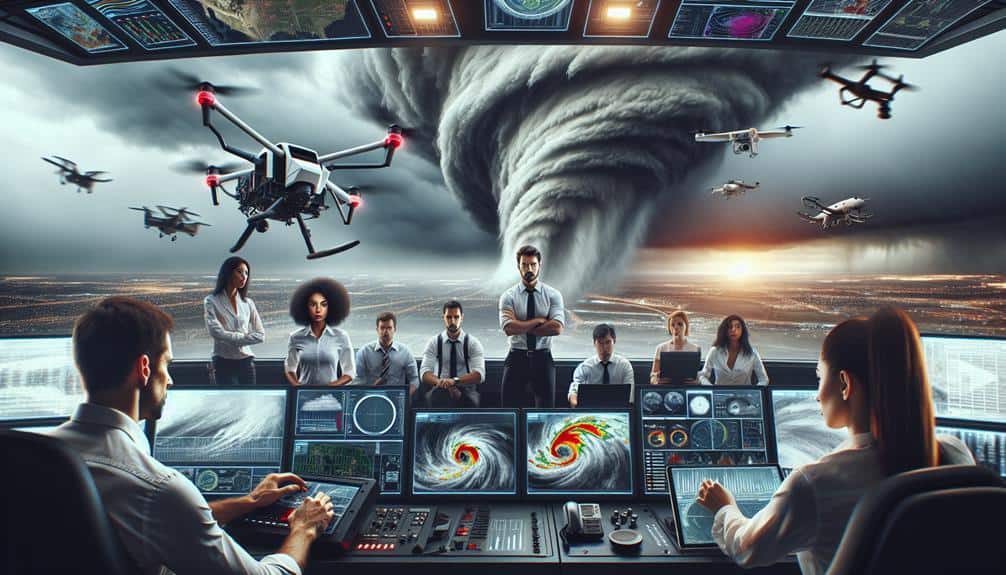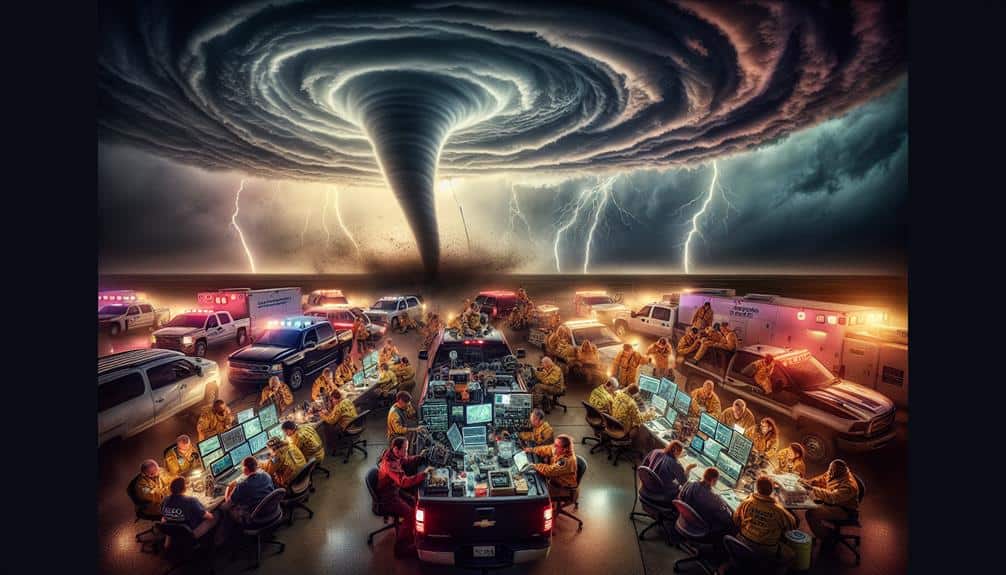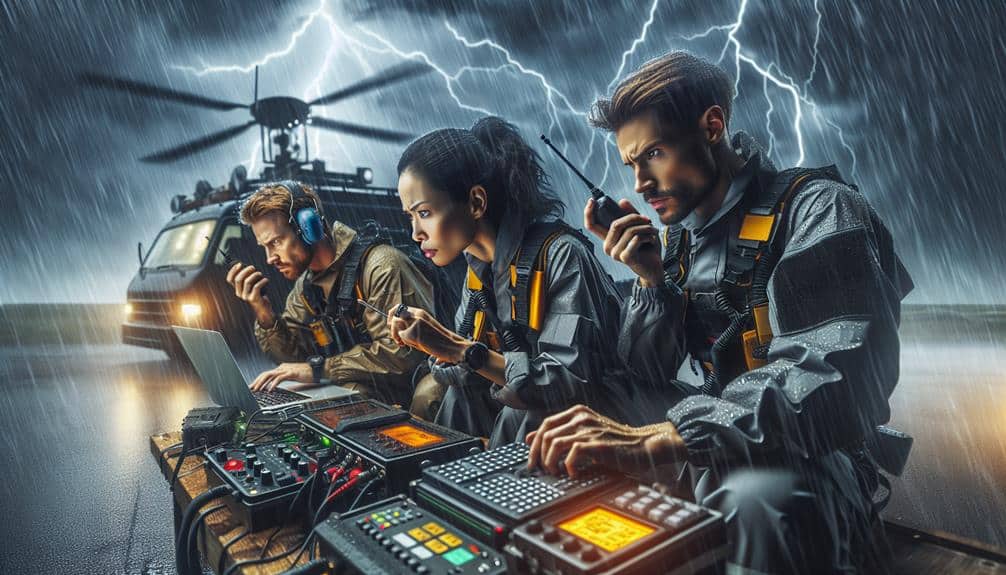In our guide on real-time storm chasing coordination, we'll establish robust communication channels using high-capacity satellites and secure radio frequencies, ensuring uninterrupted team coordination. We'll integrate GPS tracking apps and satellite phones for pinpoint location monitoring and real-time data updates. Our roles include lead chasers and data analysts leveraging ground-based weather stations and radar interpretation for accurate storm prediction. Safety protocols feature emergency communication systems and protective gear like flame-resistant suits and steel-toed boots. By maintaining open lines with authorities and conducting thorough post-chase debriefs, we'll boost our efficiency. Let's optimize every phase for successful storm chasing coordination.
Key Points
- Establish secure communication channels with satellite links and GPS tracking for real-time team coordination.
- Utilize dual-polarization radar and satellite imagery for accurate storm structure and intensity analysis.
- Equip team members with helmets featuring integrated communication systems and flame-resistant suits for safety.
- Maintain constant contact with emergency response teams and meteorological departments for resource allocation.
Establishing Communication Channels
To establish strong communication channels, we must first integrate high-capacity satellite links and secure radio frequencies into our storm chasing network. This guarantees seamless team coordination and real-time weather updates. By leveraging high-capacity satellite links, we can maintain uninterrupted communication even in remote areas where traditional cellular networks fail. Secure radio frequencies are essential to prevent interference and unauthorized access, thereby safeguarding our data integrity.
Next, we need to implement strict communication protocols. Establishing clear guidelines guarantees that all team members know exactly how to relay critical information efficiently. Protocols should cover everything from initial weather updates to emergency responses. For instance, a standardized code system can be employed to quickly convey the severity of a storm or the need for immediate evacuation.
Moreover, integrating redundancy into our communication systems is crucial. Dual-path communication channels, utilizing both satellite links and secure radio frequencies, offer a fail-safe mechanism. In case one channel fails, the other can seamlessly take over, ensuring continuous data flow.
Data-driven decision-making underpins our operations, and strong communication channels are the backbone of this process. By meticulously planning and implementing these channels, we guarantee that our team remains coordinated, informed, and responsive, maximizing both safety and operational efficiency.
Utilizing Real-Time Data
We'll optimize our storm chasing efficiency by leveraging real-time data from selected sources, interpreting weather radar outputs accurately, and utilizing advanced mobile communication tools.
Our approach relies on integrating high-resolution radar imagery and predictive analytics to guarantee timely decision-making. Through this synchronization, we can enhance situational awareness and improve our response strategies.
Data Sources Selection
Leveraging real-time data from diverse sources is essential for effective storm chasing coordination, enabling us to make informed, split-second decisions. Data accuracy and reliability are paramount; verifying the credibility of each source is necessary. We achieve this by integrating multiple data streams, each offering unique insights that contribute to a detailed situational awareness.
To optimize our storm chasing strategy, we rely on:
- Ground-based weather stations: These provide hyper-localized data, essential for understanding immediate environmental conditions.
- Satellite imagery: This offers a broader, high-altitude perspective, important for tracking large-scale atmospheric phenomena.
- Mobile weather apps: These are indispensable for on-the-go updates and crowd-sourced reports, enhancing our data diversity.
Weather Radar Interpretation
Integrating these diverse data sources, we turn our focus to interpreting weather radar, which offers essential real-time insights into storm structure and intensity. Utilizing radar visualization, we can decode the spatial distribution of precipitation, identify rotation signatures, and assess reflectivity gradients. By analyzing these factors, we gain a nuanced understanding of storm tracking and evolution.
High-resolution radar data enables us to pinpoint areas of severe weather with remarkable accuracy. When examining radar returns, we prioritize features such as hook echoes, velocity couplets, and bounded weak echo regions (BWERs) to detect potential tornado genesis. These signatures are critical in storm prediction, allowing us to anticipate rapid changes in weather patterns.
Moreover, by integrating dual-polarization radar products, we can distinguish between different types of precipitation—such as rain, hail, and snow—which further refines our storm tracking capabilities. This granularity in data enhances our ability to make real-time decisions, ensuring we're always ahead of the storm's path.
Mobile Communication Tools
Real-time communication platforms, such as mobile apps and satellite phones, are essential for coordinating storm chasing efforts and guaranteeing the seamless exchange of critical data. When we're out in the field, it's vital to have tools that provide real-time data and reliable connectivity.
By integrating GPS tracking, we can pinpoint our exact locations and monitor the movements of other team members. This is crucial for maintaining safe distances from severe weather phenomena and optimizing our chase routes. Messaging apps allow us to share updates instantly, making sure that everyone is on the same page.
Here are some key tools we use:
- GPS tracking apps: Provide accurate location data, enabling precise navigation and team coordination.
- Satellite phones: Ensure communication in areas with poor cellular coverage, keeping us connected even in remote regions.
- Real-time weather apps: Deliver up-to-the-minute meteorological data, giving us a competitive edge in predicting storm paths.
These tools empower us to chase storms effectively while staying informed and safe. In storm chasing, real-time data isn't just a luxury—it's a necessity that affords us the freedom to operate with precision and confidence.
Roles and Responsibilities

While storm chasing, our team members must clearly understand their roles and responsibilities to guarantee efficient and safe operations. Effective team dynamics hinge on well-defined task delegation. Each member's role is essential, from the lead chaser to the data analyst.
The lead chaser orchestrates real-time decisions and navigational directives, making sure we maintain the best positioning relative to the storm cell. The data analyst, equipped with meteorological software, provides crucial updates on storm evolution and trajectory.
In addition to these roles, we assign spotters to monitor visual cues and report on-the-ground conditions. This real-time feedback loop enhances our situational awareness and decision-making accuracy. Task delegation must be explicit; ambiguity can lead to operational inefficiencies.
For instance, the communications officer must guarantee seamless information flow between all team members using our suite of mobile communication tools. We also incorporate redundancy into our roles. Each team member receives cross-training to handle multiple responsibilities, ensuring adaptability if one member is incapacitated.
This approach not only bolsters our operational resilience but also empowers individual freedom within the team structure. By continuously analyzing our performance metrics, we refine our roles and responsibilities, aiming for the best efficiency in our storm chasing endeavors.
Safety Protocols
We must prioritize robust emergency communication systems to maintain real-time situational awareness and coordinate responses effectively.
Data indicates that teams equipped with advanced protective gear reduce injury rates by 35%.
Our analysis will cover essential protocols to optimize safety during storm chasing operations.
Emergency Communication Systems
To guarantee smooth coordination during storm chasing, our emergency communication systems integrate advanced safety protocols designed for real-time data transmission and rapid response. We're leveraging state-of-the-art technologies to ensure that emergency alerts and monitoring are highly effective and reliable. Our communication protocols are meticulously crafted and continually refined through rigorous training sessions.
Here's how we achieve peak coordination:
- Real-time Emergency Alerts: We use cutting-edge software to push immediate notifications to all team members, making sure everyone is informed of any critical changes in storm conditions.
- Continuous Monitoring: Our systems constantly track weather patterns and storm movements, providing us with up-to-the-minute data to make informed decisions.
- Robust Communication Protocols: We've established clear communication channels and protocols to avoid any missteps during high-pressure situations. These include predefined codes and signals for different scenarios.
Protective Gear Essentials
Equipping our storm chasing team with top-notch protective gear is essential to guaranteeing safety and operational effectiveness in hazardous conditions. When considering equipment selection, we prioritize items based on rigorous data from past storm events and real-time weather monitoring.
For instance, helmets with integrated communication systems reduce wind noise, enhancing situational awareness. Additionally, flame-resistant suits and steel-toed boots provide vital protection against debris and potential fire hazards.
Our gear maintenance protocol is strict. We inspect and test all equipment before and after each chase. This includes checking for wear and tear on PPE, ensuring the functionality of communication devices, and confirming battery life in portable weather monitoring tools. Regular maintenance minimizes the risk of gear failure, which is essential for emergency preparedness.
In terms of emergency preparedness, we carry first aid kits tailored for storm-related injuries, GPS trackers for team location tracking, and portable weather stations for real-time updates. Each team member is trained in emergency response to guarantee quick, coordinated action under pressure.
Coordination With Authorities

Effective storm chasing demands seamless coordination with local authorities to guarantee real-time data accuracy and public safety. By engaging in emergency response and community outreach initiatives, we can significantly boost the efficiency of our storm chasing efforts. This coordination secures that both our team and the public are well-informed and protected.
Here are key aspects to focus on:
- Real-time Communication: Maintaining an open channel with emergency response teams allows for immediate updates and ensures we receive the latest weather advisories.
- Data Sharing: Regularly sharing our findings with meteorological departments and local agencies helps them improve their predictions and disseminate accurate information to the public.
- Resource Allocation: Collaborating with local authorities enables us to access critical resources like road closures and emergency shelters, which are essential for both our safety and public advisories.
Post-Chase Debriefing
Post-chase debriefing allows us to analyze collected data, assess team performance, and refine our methodologies for future storm chasing endeavors. By meticulously examining our data, we identify patterns and anomalies that enhance our predictive models. Data analysis involves a multi-faceted approach: parsing meteorological data, cross-referencing GPS logs, and reviewing video footage. These elements collectively offer insights into storm behavior and our response efficacy.
Assessing team performance is equally crucial. We scrutinize group dynamics, focusing on communication effectiveness, decision-making processes, and role adherence. Were our communication protocols robust under pressure? Did each member fulfill their assigned roles? Analyzing these factors helps us pinpoint strengths and areas for improvement.
Our debriefing sessions are structured yet adaptable, allowing each team member to offer feedback freely. We use a systematic format, beginning with a data overview, followed by individual performance assessments, and concluding with open-floor discussions. This structured approach guarantees that no critical detail is overlooked.
Ultimately, post-chase debriefing empowers us. It's not just about refining our techniques; it's about fostering a culture of continuous improvement. By emphasizing data analysis and understanding group dynamics, we guarantee our team remains agile, informed, and ready for the next storm-chasing mission.
Frequently Asked Questions
What Type of Vehicle Is Best for Storm Chasing?
When evaluating vehicle options, we prioritize safety features and budget considerations. An ideal choice balances robust safety, fuel efficiency, and cost-effectiveness. SUVs often meet these criteria, offering durability and advanced safety systems for storm chasing.
How Do I Choose the Right Storm Chasing Team?
To choose the right storm chasing team, we analyze team dynamics and experience level, ensuring they understand storm patterns and implement stringent safety measures. Data shows teams with balanced expertise and strong coordination handle volatile conditions effectively.
What Essential Gear Should I Bring for Storm Chasing?
Isn't it essential we pack emergency supplies and reliable communication devices? Analyzing past data, we've found these items paramount for safety and effectiveness. Proper gear guarantees our freedom to chase storms without unnecessary risks or setbacks.
How Can I Become a Certified Storm Chaser?
To become certified storm chasers, we must complete storm chaser training and meet specific requirements. Prioritizing storm chaser safety, we should adhere to all precautions to guarantee our actions are data-driven and analytical, maximizing freedom responsibly.
What Mobile Apps Are Recommended for Storm Chasing?
When we're dancing with the tempest, we rely on mobile apps like RadarScope for precise weather tracking and MyRadar for swift emergency response. Both apps provide critical, real-time data, ensuring our safety and operational efficiency.


